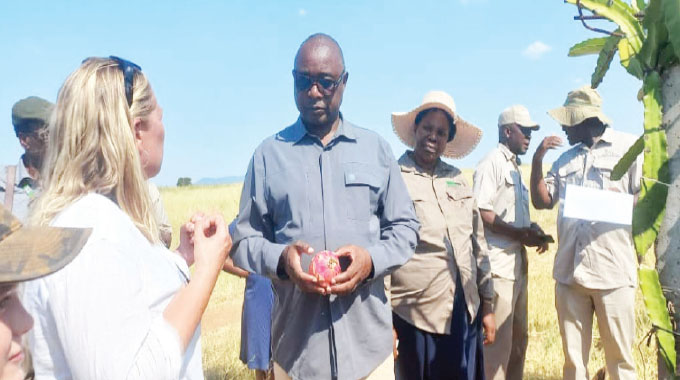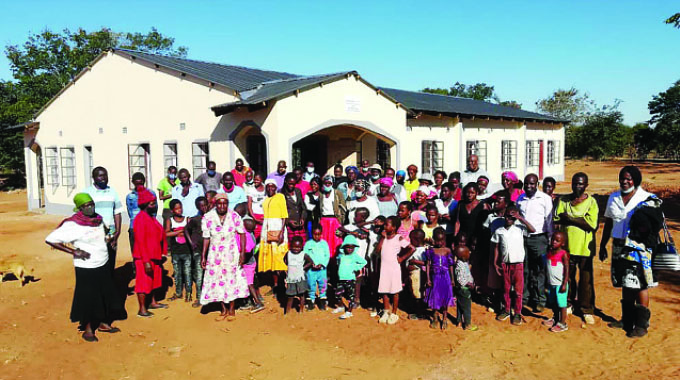Makhado farmer pioneers dragon fruit production

Sukulwenkosi Dube-Matutu, [email protected]
TUCKED deep in Makhado, Beitbridge district in Matabeleland South, Double O Ranch popularly known among locals as Magwamazi Farm, is an enviable integrated farming model where the owner, Mrs Elani Watson, has ventured into the first-ever production of dragon fruit in the country.
Through her efforts, Mrs Watson is redefining her successful farming story, contributing significantly to food security for the nation in line with the Agriculture and Food System Transformation Strategy (2020-2025) whose thrust is to see Zimbabwe achieve a US$8,2 billion agriculture economy by 2025.

The strategy, which was launched by President Mnangagwa in August 2020, is underpinned by growing the economy and ensuring Zimbabwe grows its own food.
Mrs Watson’s farm, which sits on 2 000-hectares, boasts 1 000 hectares of dragon fruit that is destined for export markets, 10 hectares of tomatoes, 60 hectares of potatoes, and a herd of 500 cattle.
The dragon fruit is an oval-shaped vibrantly coloured hot pink tropical fruit that grows under a family of cactus called Hylocereus. The fruit is native to Central America but is now grown and harvested worldwide.
The dragon fruit, also known as pitahaya or strawberry pear, has become popular because of its health benefits. It is a low-calorie fruit with essential nutrients. It contains a substantial number of vitamins, minerals and fibres.
It acts as an antioxidant and helps to fight inflammation and cell damage. The fruit contains potent antioxidants like carotenoids and betalains that help to prevent diseases like cancer, diabetes, heart problems and arthritis.
Dragon fruit also contains Vitamin C which acts as a barrier and prevents infections by protecting white blood cells.
Often served raw, the fruit can be used as part of a dessert, cocktail, fruit salsa and smoothie, and it is drought-resistant.
Mrs Watson, a member of the Southern Africa dragon fruit Association, has also opened up 180 hectares for irrigation development with centre pivots commanding 100 hectares. She has 10 hectares under tomato production, 15 hectares under forage sorghum, 60 hectares under potato production and 30 hectares under wheat.
Mrs Watson also grows grasses for hay bailing. Under livestock production, she has about 500 pedigrees.

The Dragon Fruit plants
In an interview, Mrs Watson said they have been going through a four-year trial period to see how the dragon plant performs under various weather conditions.
“I’m glad to say that we are the first producers of the dragon fruit in the country. We are looking for an export market for this fruit as its high value. We are targeting various markets such as Europe and Asia,” she said.
“The dragon fruit is a huge investment opportunity that needs to be exploited. So far in Africa, it’s being produced on small hectares of land, but it has the potential to grow like citrus and that’s where we want to take it.”
Mrs Watson said this year, they were testing the plant for endurance under extreme heat.
“For now, we are getting about one tonne of fruit per hectare. We plan to increase the hectarage from 1,4 hectares to four hectares,” she said.
As part of their corporate social responsibility, Mrs Watson said they have community-targeted projects where they grow sorghum and various rotational crops, which they donate to the underprivileged such as orphans, widows and people with disabilities and schools.
“Here we grow various crops. We have had minimal to very low rainfall and we have combated this by irrigating. We have drip irrigation and we also have centre pivots irrigating sorghum that will go towards silage and feed fodder for the cattle to see them through the winter period,” said Mrs Watson.

“We also grow tomatoes mostly during winter time because we are a frost-free area. We usually reach up to 120 tonnes per hectare for our tomatoes. We ensure that we incorporate different dynamics in our production.”
Speaking during a tour of the farm as part of a crop and livestock assessment programme, Lands, Agriculture, Fisheries, Water and Rural Development Deputy Minister Davis Marapira said irrigation farming is the mainstay of Matabeleland South and commended Mrs Watson and other commercial farmers running thriving farming projects, which have helped food security in the country.
“This is a very productive farm where there is a mixed type of farming. We have both intensive crop and livestock production. There is the new dragon fruit which I’m seeing in the country for the first time,” he said.
“This is a very good export crop and this is the kind of farming we want where farmers explore new crops and produce for export. We have also seen 10 hectares under tomato production.”
Deputy Minister Marapira said Double O Ranch is a shining example of successful commercial farming.
“I am pleased to see the dedication and hard work that goes into maintaining this operation. Zimbabwe needs such aspirations and a positive move towards V30 accelerator models,” he said.
Deputy Minister Marapira noted that crops under dry land are under moisture stress while those under irrigation are doing well.
The El Niño weather phenomenon is being experienced across Southern Africa and is characterised by high temperatures and prolonged dry spells.
Deputy Minister Marapira said farmers must adopt sustainable and resilient farming practices to mitigate risks and ensure long-term success. He urged farmers to embrace new technologies and modern farming methods and to diversify their crops and livestock to increase productivity and income.
@DubeMatutu












Comments